Angel Egg Salad Shooter
It’s the first week of major exams, so it’s time once again for the obligatory movie night. Unfortunately, Jack never got the memo that the movies shown should actually be good and/or entertaining. Instead, we have whatever he dredged from the bottom of a couple abandoned forum threads. On the plus side, this showing also begins this semester’s repeater anime (you might recognize it from our website banner): Black Rock Shooter. Settle in, this review is as painful as it is long.
Tenshi no Tamago (Angel’s Egg)

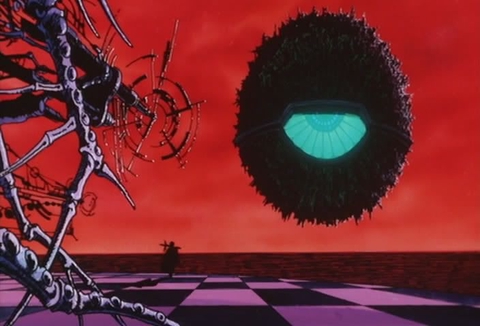
Remember that look. You’re going to see a lot of it.
During the opening credits, a little girl who is completely white with disheveled hair, is seen carrying something alone across an eerily dark landscape. The movie takes copious amounts of time to observe various parts of the dark forest: the rocks, the grass, the tree branches, the rippling waves. Next, she passes through a town, equally dark and equally abandoned. Again, the girl stoically observes various parts of the city (almost entirely through panning still shots).
Suddenly, the slow grind and whine of machine approaches as a fleet of red tanks passes through the street. One tank stops in front of the girl, and the young man from before gets out and stands in front of her.
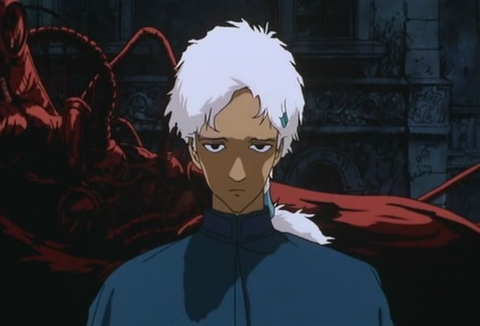
With the same vapid expression as everyone else in this place.
The two stare at one another for a moment before parting ways. Every so often, the girl is seen refilling a large spherical flask with water, inspecting the contents, and drinking it.
Suddenly, a bell tolls and a bunch of grey background characters appear, kneeling for some reason. The girl backs away and runs until the bell stops ringing. She then reveals what she has been carrying: a giant egg. While staring at the ripples in a pond, she notices the same boy from across the way. She approaches him, but appears surprised when she notices the egg is gone. The young man presents the egg, telling her to keep precious things inside, lest they get lost. He is curious as to what the egg holds, but she declines to answer. So he starts following her, despite her wishes. Unfitting music is played.
Later, during a small rain storm, the two notice a bunch of men flooding the streets, running with spears. The girl comments that they are after fish, even though there are no fish. She then realizes that she is standing underneath the man’s cloak, sheltered from the rain. The men are seen throwing their spears at the images of fish, but they are actually just shadows.
The girl is then seen standing in the middle of a dark and empty church, staring up at a giant stained glass window. She marvels at her reflection in the window as she stares out at the town, filled with men and spears and the silhouettes of giant fish. Spears are thrown in every conceivable direction, but because the fish are merely shadows, the spears only pierce the ground and buildings. The pair leaves the city and begin wandering across a field of monoliths. The girl then runs in front of the boy, telling him to promise not to do anything to her egg.
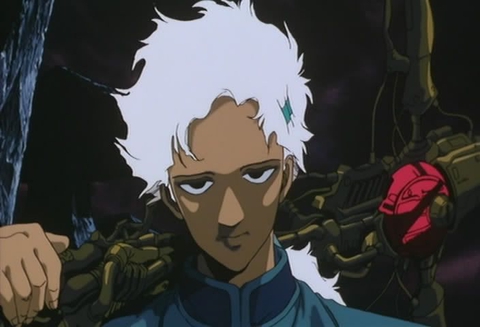
Sarcastic silence means yes. Always.
They enter what looks be a giant arc and see a carving of the Tree of Life. The young man recalls seeing the tree before, noting in a dream that he witnessed a giant bird inside an egg at the top of the tree. He again asks what is inside the girl’s egg. They continue through the structure, filled with staircases and fossils and bottles. The two sit down, and both note that they cannot remember where they came from. The young man then talks about the Great Flood from biblical history, comparing it to their situation. He then waxes philosophical about their existences, the fish, and the complete lack of birds in the world. They continue through the long hallway and notice the skeleton of what looks to be an angel, holding it head in its hand. As the rain continues outside, the girl clutches the egg close to her chest. The girl claims to hear breathing a wing beats from inside the egg, which the young man explains away as her own breathing and the outside wind. After carrying her off to bed, she asks the man who he is. He asks the same of her, and she falls asleep. He stays awake until she’s fast asleep. Unfitting music is played for the next 3 minutes. He then takes the egg and strikes it. The video then cuts to the world becoming slowly inundated. The girl awakes to find the man gone and the egg in pieces.

I tell you not to do literally ONE THING.
She then screams a few times, runs out of her home. She sees what appears to be the man across the fields and runs toward him. Unfortunately, she falls into a chasm in the fields, supposedly to her death. Then multiple eggs are shown in the water as the flood recedes. The man stares out in the distance as the giant floating steampunk eye emerges from the sea. The eye is covered in stone statues of people, with one of them resembling the little girl sitting with an egg in her lap. The picture steadily zooms out, revealing the surrounding landscape, which cast a shadow resembling an arc on the water that covers everything else.
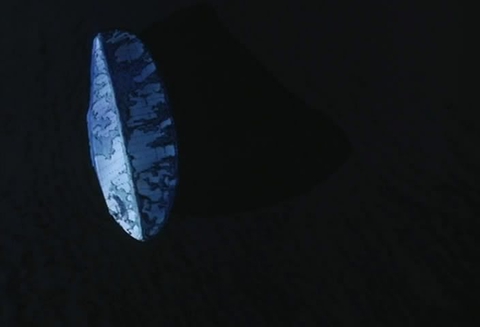
If the story’s setting looks small, it’s because it is.
If the 1980’s could be acutely summarized, it would entail the fragmentation of rock and roll and the growing global fear of a nuclear apocalypse. In Japan’s most expressive medium (anime), there subsequently grew a dichotomy in style. One side chose ever more violent stories of endless war and death, while the other side chose to wax philosophical using the most abstract of storylines. Enter the 1985 classic, Angel’s Egg.
The film is produced by the then famous Studio DEEN, animated by Yoshitaka Amano (responsible for the Final Fantasy and Castlevania video game designs), and directed by an up-and-coming fellow named Mamoru Oshii (who would later direct Patlabor and Ghost in the Shell). During the 1980’s, Japan enjoyed an economic boom, an international exportation of anime was seeing unprecedented growth. As such, directors were often given complete creative control over whatever project they wanted, and with no need for cross-merchandising efforts, Oshii decided to create a very controversial (and therefore memorable) film. Aside from roughly 3.5 minutes worth of dialogue, Angel’s Egg is basically a silent film set to orchestral music. At least 30 seconds of said dialogue is the repeated question “Who are you?” The viewer has no idea who the girl or the soldier are, what their backgrounds are, what their motives are, or even what effect their actions have on the overall story. Add to it the intensely dark gothic imagery, the endless symbolism, and the vague conclusion, and the story becomes confusing fast. But that’s the point. With so little concrete information given (least of all about the main characters), the viewer frantically tries to fill in the holes with whatever they can think of. Angel’s Egg is more concerned with creating an atmosphere and a mood than it is telling a cohesive story, as it couples striking images to equally striking audio. That makes the story and the characters unique to every viewer, so it’s difficult, almost meaningless to give an “opinion” that will resonate with others.
The artwork and animation play an unusually large role in Angel’s Egg. Since there is so little dialogue and the music follows the art (in a manner eerily similar to Fantasia), the animation becomes the driving force of the story. That said, the film is more concerned with creating detailed surroundings and crafting atmosphere than it is with super fluid motion. At the time, many Japanese animators subscribed to the theory that anime need not strive for complex fluid animation, but instead exist somewhere between the still and detailed drawings of manga and perfectly fluid western (i.e. Disney) animation. Angel’s Egg embodies this notion through frequent panning and minimal character movement. Minimal character expression also plays well into the film’s overall objectives, since everyone’s poker face is easy to constantly draw and doing so never reveals a character’s emotional response. However, intense detail is given to the simple motion of objects, such as wind causing grass to sway or water bubbling in a brook, or individual strands of frayed hair blowing in the breeze. Such contrast undoubtedly is meant to further perplex viewers as to what should actually be paid attention. Although the designs for the characters and the cityscapes in the film are stunning, at times the animation itself is not as fluid or complex as one might hope for.
The music almost exclusively follows the film’s animation, artfully augmenting the scenery, but it occasionally takes center stage and brings its own form of drama. Composed by Yoshihiro Kanno, the intense soundtrack becomes a strange union of classical composition and progressive-rock. Moments of pounding war drums and haunting melodies are matched only by the moments of sublime beauty, complete with disturbingly high string swells and atmospheric soundscapes. The music in Angel’s Egg effectively exploits holes purposely created by the director in order to further confound and inspire viewers.
Overall, Angel’s Egg is more of a Rorschach test than an actual movie. Mamoru Oshii has very successfully provoked audiences with a work that simultaneously accomplishes so much and yet so little. Existentialism abounds, heightened by the moody artwork and a dialogue that generates far more questions than it answers. This film is obviously a thinker’s game, and it should be treated as such. If you need a storyline, action, or dialogue to keep your attention, stay far away from this movie. However, if you dare to rise to the challenge, then it’s easy to see why Angel’s Egg remains one of the most iconic films in early anime.
Armored Trooper VOTOMS – Alone Again
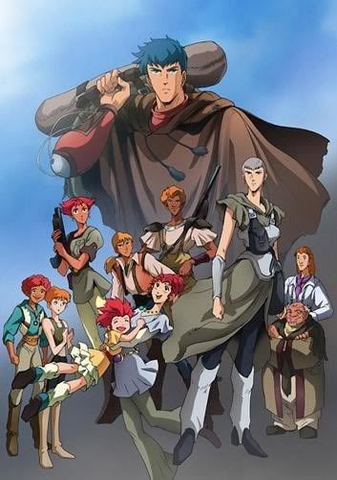
ForeverAlone.jpg
During 60 seconds of a most disorienting recap from the previous story, it is explained that the Gilgamesh and Balarant armies have been waging a religious (and therefore physical) war across the galaxy using mechs. The video cuts to Lady Teitania, who promptly kills some people sent to assassinate her. She takes their space ship and heads off to parts unknown. Meanwhile on a space station, we see the main character Chirico Cuvie passing virtually undetected through immigration. After sneaking onto a food transport down on the desert planet below, he is fired upon by some mechs. He steals one of the mechs and destroys the other two, much to the amazement of the transport driver. It turns out she is related to some old acquaintances of Chirico before he was sealed away, so they do some catching up at her mother’s home.
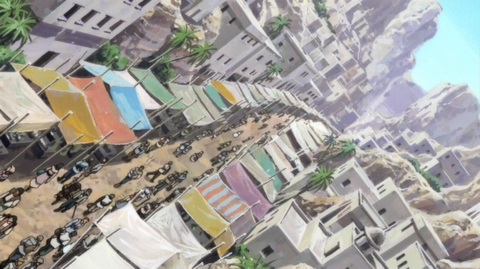
But not before 7 more panning 360-shots.
The Black Lightning forces of the Gilgamesh army then pass into town, tearing shit up. They are looking for the mechs that the family has been smuggling onto the planet using their shipping business. Although Chirico leaves in a hurry to prevent misfortune from befalling the family, the Black Lightning forces begin systematically destroying any convoys heading out of the city. The leader of the city’s church has been trying to amass mechs, do some shadow-governing, and finally become ruler of the city in order to fight off the oncoming invaders. Unfortunately, Chirico shows up and kills the church leader. As the Black Lightning forces approach, Chirico pilots a lone mech and with perfect accuracy and superior main character skills, he destroys a large number of enemy mechs. Meanwhile, Lady Teitania makes her way to the planet while trying to avoid getting shot at by enemy forces. It is at this point that the Balarant army drops in, and the two armies have a little skirmish. Teitania is badly wounded, so Chirico hands her mech a couple guns to defend herself with.
After the battle ends, Chirico surveys the battle scarred landscape and finds Teitania in her ruined mech. Although she tells him to look up at the sky as his encapsulated wife whizzes unconsciously through space, he instead simply stares at Teitania, who finally embraces him. The girl from before surveys the battlefield looking for Chirico, but instead only finds Teitania’s grave, surrounded by flowers. She then closes with a short epilogue.
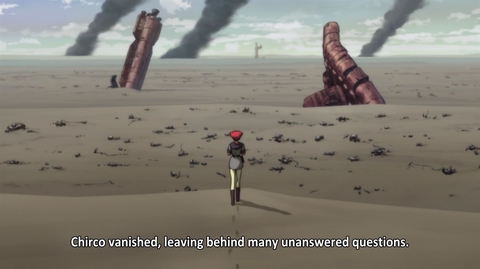
Like why anyone would willingly watch this.
Armored Trooper VOTOMS first started out as a 52-episode saga in the halcyon days of NINETEEN EIGHTY THREE. Not-so-good guy Chirico Cuvie was a soldier at the tail end of the 100-year war between two planets, and through a set of ironic circumstances, has become genetically immortal. As such, he is viewed as some kind of super human capable of mass destruction. So he’s either chased down because he’s dangerous, or because someone wants to use his power, or because his death would bring glory and bragging rights to whoever kills him. Chirico is therefore obliged to kill them in turn. This OVA (the last in a long, long line) remains attached to this formula, and the result is…boring. This story is supposed to serve as the missing link between two previous OVA’s, and the movie feels as infinitesimally incremental as it sounds. Aside from catching up on some old friends and watching Teitania die a cameo death, Chirico has no purpose whatsoever being on this planet. If both the premise and the characters are forced together, then why should the viewer feel compelled to endure another 40 minutes? As for the animation, you would swear it is from the 1980’s if not for the liberal use of middling modern CG. The music is all but worthless, aside from some decent BGM for the fight scenes. However, even the fight scenes feel contrived, especially during the final confrontation where Chirico defeats the Gilgamesh forces Rambo-style. Overall, the OVA is just abysmal, and even fans of the VOTOMS franchise should probably stay away from this one, but any completionists out there will probably watch this anyway. Pity them.
Black Rock Shooter 1 – 2
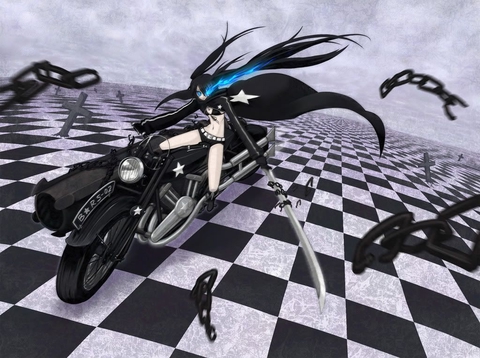
Ride on, shooting star.
The series opens with some poetic observations amongst a strange landscape as we see the Black Rock Shooter fighting….something. Cut scene to a middle-school entrance ceremony and a shot of the main character, Mato. She takes great pleasure in stating the obvious, such as weeds BLOOMING, sakura petals are FALLING, and that a bracelet is RED (doesn’t Japan already have schools for children like this?). She becomes interested in one of her new classmates named Yomi, mostly because of her pale white skin, green eyes, and symbolism behind her name (which means “playful little bird”). Mato tells her old friend Yuu all about this new potential friend. Later, she reads a children’s picture book called “The Tiny Bird and the World of Many Colors,” further emphasizing her obsession with birds and colors. Meanwhile, Yomi goes home to her depressing house and has a depressing conversation using cans and a string with a depressing person in the next room. At school, Mato tries to talk to Yomi, but Yomi avoids her. Yuu takes Mato to see the school’s guidance counselor, Saya, who for some reason pushes coffee on every single person who walks through her door. Later, the three girls start looking for clubs to join, with Mato choosing basketball, Yuu choosing to be the team’s manager, and Yomi deciding to join the art club.
After school Mato goes over to Yomi’s house and discovers that Yomi shares her great love of the picture book (because it’s basically about her), and everything is going great. Suddenly, a voice calls out from outside Yomi’s room, to which see Yomi promptly freaks out. In enters a blond girl about their age in a wheelchair. Her name is Kagari, is Yomi’s half-sister, and is none too pleased to see Mato. She proceeds to treat Mato like crap: displaying passive aggression, giving her deformed dolls, forcing her to eat a bunch of obscure macaroons, calling her fat, standard evil little girl stuff. Mato puts on a brave face while at Yomi’s home, but she cries in her own bed that night. Yomi, in turn, feels horrible that her sister has driven out the only person Yomi has any sort of connection with. Meanwhile in the Other World, the Black Rock Shooter follows a wisp of green smoke into another realm.
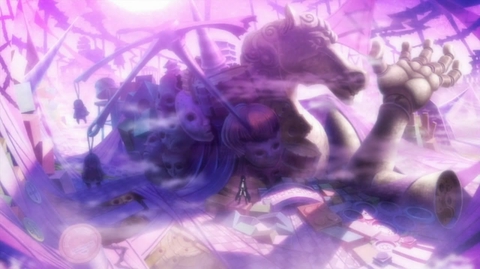
Which looks like the most deranged Wario Party ever.
While wandering about, she notices a giant dollhouse overhead that seems to emanate that green smoke from before. She is subsequently bowled over by her first enemy of many: The Chariot.
The next day, Mato seeks advice from the guidance counselor when Yomi ignores her during class. However, the office is already occupied by Mato’s team captain, Kohata, who is voicing her angst over a boy that she likes. After Kohata rushes off in an embarrassed hurry, Saya listens to Mato’s dilemma (but not before making her chug another cup of mud). She tells Mato that she is young, and therefore has not experienced rejection before. However, this is nothing to be concerned about, not because Yomi is ok or that they can both make other friends, but because emotional pain can’t physically hurt humans. Instead, something else bears that pain for them. Mato seeks Yomi out after school, and Yomi warns her not to get close. Mato promises not to get hurt and wants to get to know Yomi. This response, disregarding the problems that would arise from their friendship, causes Yomi to cry tears of joy. She finally has a friend ( BUT FOR HOW LONG?). However, in the Other World, Black Rock Shooter begins her offensive against The Chariot, but she also encounters Yomi’s analog.
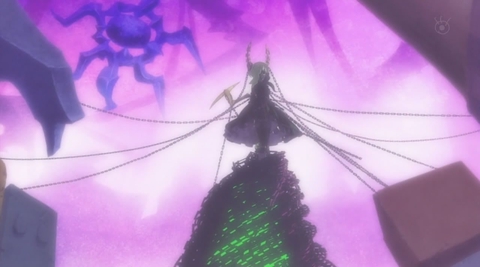
Green Chain Shooter!
Episode 2 opens with Mato preparing to attend a festival with Yomi. Although Mato diligently waits for her, Yomi is stuck entertaining Kagari. A solid two hours later, Yomi texts Mato saying that she can’t make it. In the meantime, Mato has had to turn down multiple invites from the other schoolgirls, instead opting to wait for the class weirdo. She eventually misses the entire festival and is understandably pretty pissed, but she is actually devastated that she has been effectively rejected by Yomi twice. As for Yomi, she feels equally horrible for having stood up Mato because of Kagari, who shows her appreciation by carving a shallow heart into Yomi’s chest. Later that night, Mato dreams of the fight transpiring in the Other World.
While alone in the school locker room the next day, Mato shows concern over the scar, but Yomi is upset that Mato isn’t upset. Mato obliges, going on a rant about how Yomi is not the playful little bird who was supposed to take her to the world of many colors.

Can’t you just buy a color wheel or a kaleidoscope?
Mato storms out and goes looking to make Saya bear some pain and hurt. This time around, Saya posits that Mato’s dream could actually be connecting her to Yomi, so she should not give up just yet. So while Yomi is crying in her room, Mato comes over and demands to be let in. Yomi rushes out of her room to meet her, but Kagari is sitting in her way. She even threatens to throw herself down the stairs if Yomi leaves her…and then does so anyway out of spite.
Yomi’s mom hears the thud and takes everyone, including Mato, to the hospital. Although Kagari only sprains her wrist, she claims that now her arm is paralyzed and Yomi can never leave her side. Meanwhile, Yomi’s mom explains that when Yomi was younger they had to move abroad. While Kagari was chasing after their cab, she was struck by an oncoming vehicle.
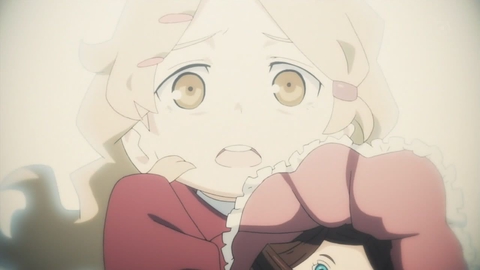
Watch out for cars!
The thing is, the doctors don’t have an explanation for why Kagari can’t walk, which leads the audience to believe that she CAN WALK but doesn’t. Both parents pity Kagari, though not enough to actually care for her (you know, like parents should). So it’s implied that Yomi should wait on her hand-and-foot and suffer the consequences. Mato finds this situation stupid and goes to rescue Yomi from the faking little psycho.
Mato demands that Yomi open the hospital room door, and Kagari is as pissed as ever. Despite Yomi’s protests, Mato says that she will only leave with Yomi by her side, causing Yomi to tear up and start smiling. As this confrontation escalates, the battle in the Other World intensifies. The Black Rock Shooter finds Dead Master imprisoned, and The Chariot isn’t letting her go without a fight.
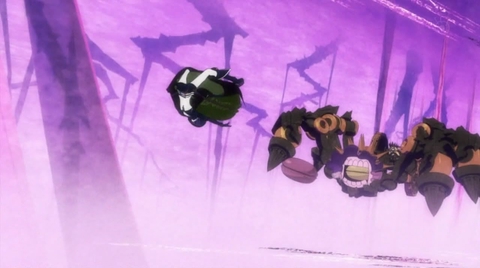
Chaos Macaroon Shooter!
Kagari is absolutely livid and can no longer keep up the act, grabbing Yomi and violently throwing her across the room and even standing up and screaming at Mato from her bed. Mato tells Yomi not to pity Kagari, since it only enables her bad behavior and makes her emotionally unstable. Kagari, now on the defensive, tries to resist Yomi’s heartfelt plea to move on with her life. However, it’s already too late. Yomi has started to think for herself. In the Other World, Dead Master breaks free from her prison, which pulls the plug on The Chariot’s realm. Suddenly, a fourth being pops in and stops the chain reaction, while also forcing Dead Master into another realm of the Other World. The Chariot tries to take advantage of the situation and attack Black Rock Shooter, but gets decapitated instead. Kagari screams, and the room falls silent. Mato wants to know what happened, and Yomi opens the door. Kagari is now sitting politely on the bed with the most unusually calm look on her face. Cue unsettling music.
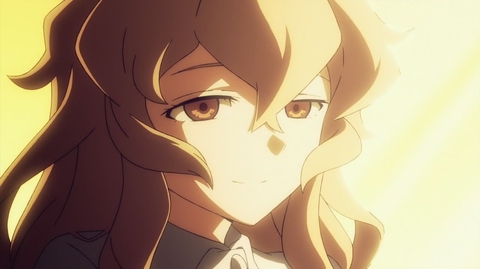
Can’t tell if suicidal or homicidal.
It has become quite apparent that anime viewers have a sadomasochistic relationship with the Magical Girl genre. Their need to return to the endless variations of the same tired tropes and messages is matched only by their desire to see the main characters endure ever more dramatic suffering. To that end, Black Rock Shooter tries to take the genre to a more unique level: a complete separation of reality and “reality” via an extended metaphor. Only Mato seems aware of the Other World, where color-coded melancholic fighters roam from realm to realm, and even then, she does not understand what she sees in her dreams or why she sees it. From there, the storyline fairly linearly parallels from world to world. While the increase in real world drama syncs nicely with the battles waged in the Other World, there seems to be a disconnect of interest. After all, it may be neat to see budget going towards action scenes, and the idea of an alternate reality where “minor issues” become a matter of life and death is intriguing, it still doesn’t change the fact that the storyline really is just a string of minor issues.
The twist is that almost all of the main characters are completely unhinged, and there’s relatively little reason for it. Kagari is a great example of this. She started out as a clingy little sister, who then somehow became a controlling little psychopath because her parents pitied her. That makes someone dependent or rebellious, not evil, but it doesn’t stop the writers from painting her that way for a solid hour. As for Yomi, I can already see in her the signs of dependence that sprouted from her extended relationship with Kagari. Then there’s Mato and Yomi’s relationship. What possible reason could two seventh grade girls have for being so obsessed over a children’s book about colors? Judging from the viewer’s introduction to Mato’s character, it’s fairly easy to see why she would be interested in such a simple story, but why is someone “with the name of a smart person” like Yomi interested enough to also glance back to this same book on a daily basis? The ending to Episode 2 is what troubles me the most. Yomi’s alter ego, Dead Master, has been sent to another realm because of that fourth being, so there’s obviously some outside interest at play that for some reason doesn’t want Mato and Yomi to become friends. Also, with The Chariot killed in the Other World, Kagari now has this disturbingly enlightened look on her face, so I’m not yet sure of what repercussions death in the Other World can have in the real world.
The animation also has some good points. The Other World obviously holds the vast majority of the animation budget, with subtle textures and color gradients visible throughout each of the thematic realms. Each realm is as unique as the alter ego of the being inhabiting it, and they are often a vivid representation of the unstable nature of the main characters. Though mostly done in CG, this animation style effectively augments the surreal look of the Other World. Unfortunately, that means that the real world takes a hit, with non-player characters looking very unpolished. The background artwork also tends to drop in quality as the episodes progress, which is disappointing. Fortunately, the main characters retain fluid motion and consistent character designs, along with occasional hair physics. The character designs themselves are actually quite tolerable, even if the real world versions are still doused in a fair amount of moe. There are still some noticeable parts where the animators cheat in terms of quality. The most notable example is during close-ups of the characters’ eyes. Instead of using CG to create details inside the iris, the animators use disconnected light and dark lines. The overall effect makes it seem as though the characters have misshapen gears in their eyes, and while the look is unique, it doesn’t quite convey the artistic effect that is intended. Still, the artwork has some niceties, especially the fact that every one of Saya’s patients are provided with their own custom coffee mug.
The soundtrack definitely has its moments in Black Rock Shooter. During the lighter scenes, the music is mostly light guitar. For more dramatic shifts, such as when Kagari is first introduced, the guitar music immediately drops, followed by a murmur of shrill stringed instruments that suddenly grows into a dull roar. Sadder music is set to piano, action scenes turn orchestral, and the downright weird scenes rely on a keyboard. The music is almost as patterned as the characters are color-coded. However, the music doesn’t just languish in the background. Its volume fluctuates with the tone of the scene. This is first noticeable when Mato and Yuu are in Saya’s office. The tone is so light that the guitar playing is nearly as loud as the dialogue. Conversely, when the scene is climatic, such as during Yomi and Kagari’s confrontation, the music becomes especially loud. While it’s nice to hear the soundtrack play a more proactive role than in most shows, it can become borderline distracting, and the story itself is tenuous enough as it is without impeding it further.
So far, the story is interesting enough that I’m curious to know what will happen, even if this wasn’t the repeater this season. Let’s see what transpires next.
In review, the moral of the story is that if you don’t have any good material for Movie Night, you shouldn’t have a Movie Night. Come back next time, as I dawn my crime-fighting attire for that most time-honored tradition: Sentai Night.